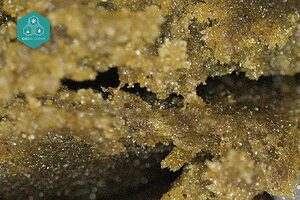- What Are Cannabis Terpenes?
- Terpene Biosynthesis in Cannabis
- The Most Common Cannabis Terpenes and Their Effects
- How Volatile Compounds and Terpenes Interact with Cannabinoids
- Cannabis Terpenes vs. Botanical Terpenes
- Therapeutic Properties and Benefits of Cannabis-Derived Terpenes
- Essential Oils and Terpenes
- Maximizing Terpene Benefits
- Cannabis Sativa and Terpene Content
- How to Use the Cannabis Terpenes Chart
- The Future of Terpene Research in Cannabis
- Conclusion
- Frequently Asked Questions about Cannabis Terpenes
- What are cannabis terpenes?
- What are cannabis-derived terpenes?
- What are terpenes in cannabis?
- Which of the following terpenes is the most abundant in cannabis?
- Outside of cannabis, where can terpenes be found?
- What does “cannabis-derived terpenes” mean?
- How many cannabis terpenes are there?
- How do cannabis terpenes work in the body?
- How to extract terpenes from cannabis?
- How to increase terpenes in cannabis?
- What is the average percentage of terpenes in cannabis oil?
- What do cannabis-derived terpenes do?
- How to isolate cannabis terpenes?
- What are the best terpenes in cannabis to relieve pain?
- How to make terpenes from cannabis?
- How to use cannabis terpenes?
- Why do cannabis terpenes matter?
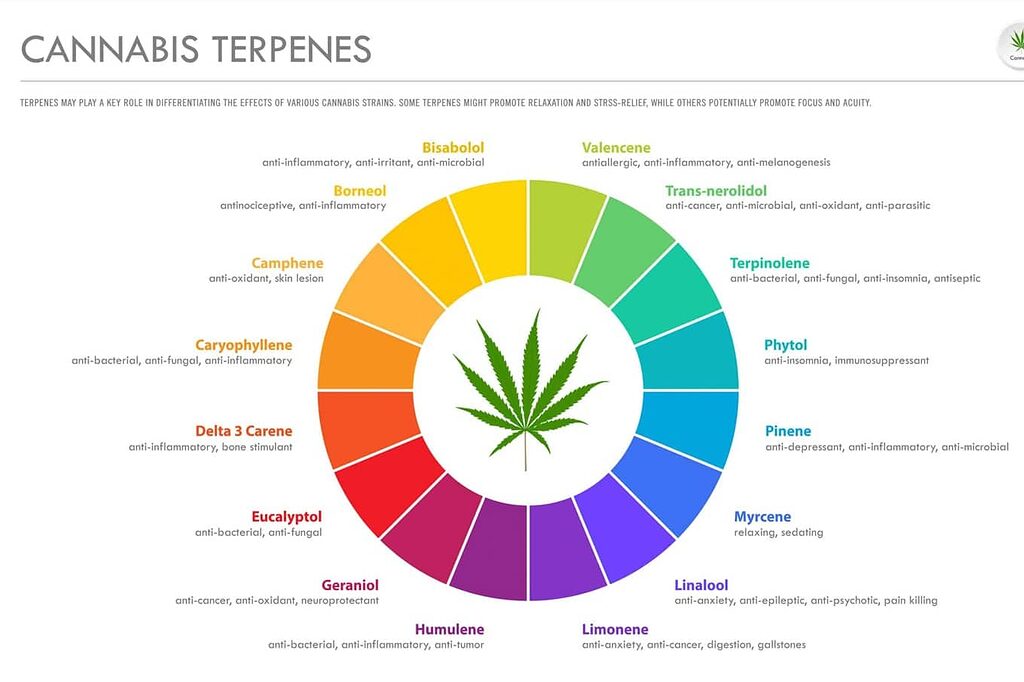
Cannabis terpenes are aromatic compounds found in the resin glands of cannabis plants, contributing to the unique cannabis plants smell, flavors, and potential therapeutic effects associated with different cannabis strains.
As the cannabis industry continues to evolve, understanding terpenes has become crucial for both consumers and producers seeking to optimize their cannabis experience.
What Are Cannabis Terpenes?
Terpenes are naturally occurring chemical compounds produced by a wide variety of plants, including cannabis. In cannabis plants, terpenes are primarily synthesized in the trichomes – the tiny, crystal-like structures on the surface of cannabis flowers and leaves.
The primary functions of terpenes in nature include:
- Protecting plants from predators and environmental stressors
- Attracting pollinators
- Regulating plant growth
In marijuana plants, terpenes not only contribute to their unique aromas but also play crucial roles in repelling pests and enhancing the plant’s immune system.
In cannabis, terpenes work synergistically with cannabinoids like THC and CBD to produce what’s known as the “entourage effect” – the theory that cannabis compounds work better together than in isolation.
Terpene Biosynthesis in Cannabis
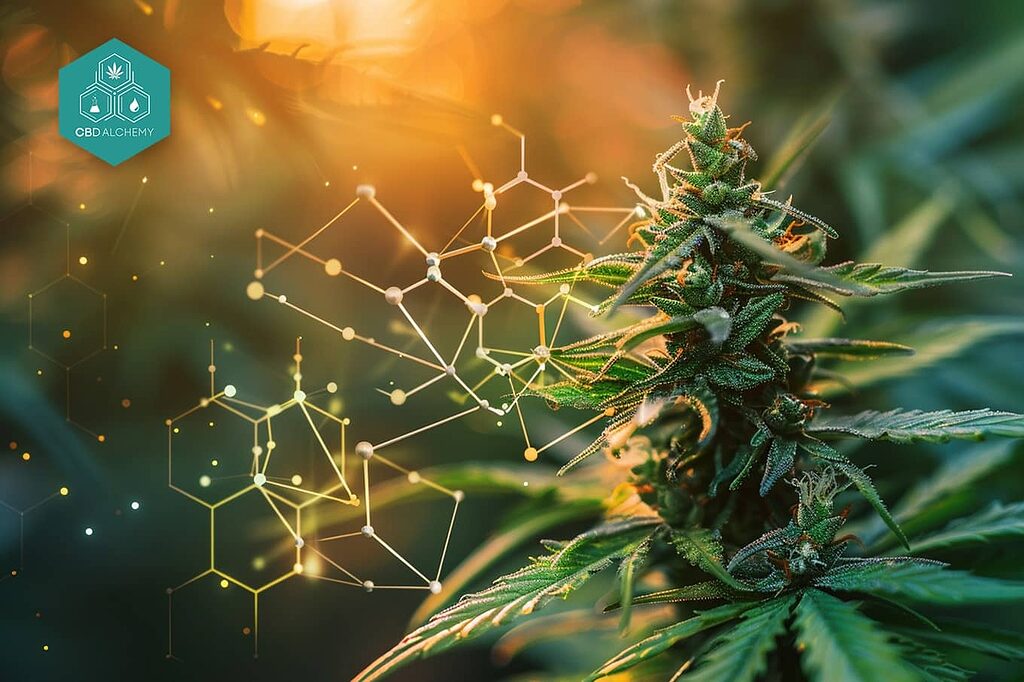
The cannabis sativa plant produces terpenes through two main biochemical pathways:
- The methylerythritol phosphate (MEP) pathway
- The mevalonate (MVA) pathway
These pathways convert simple organic molecules into the building blocks of terpenes – isopentenyl diphosphate (IPP) and dimethylallyl diphosphate (DMAPP). Specialized enzymes called terpene synthases then catalyze reactions to form the diverse array of terpenes found in cannabis.
The Most Common Cannabis Terpenes and Their Effects
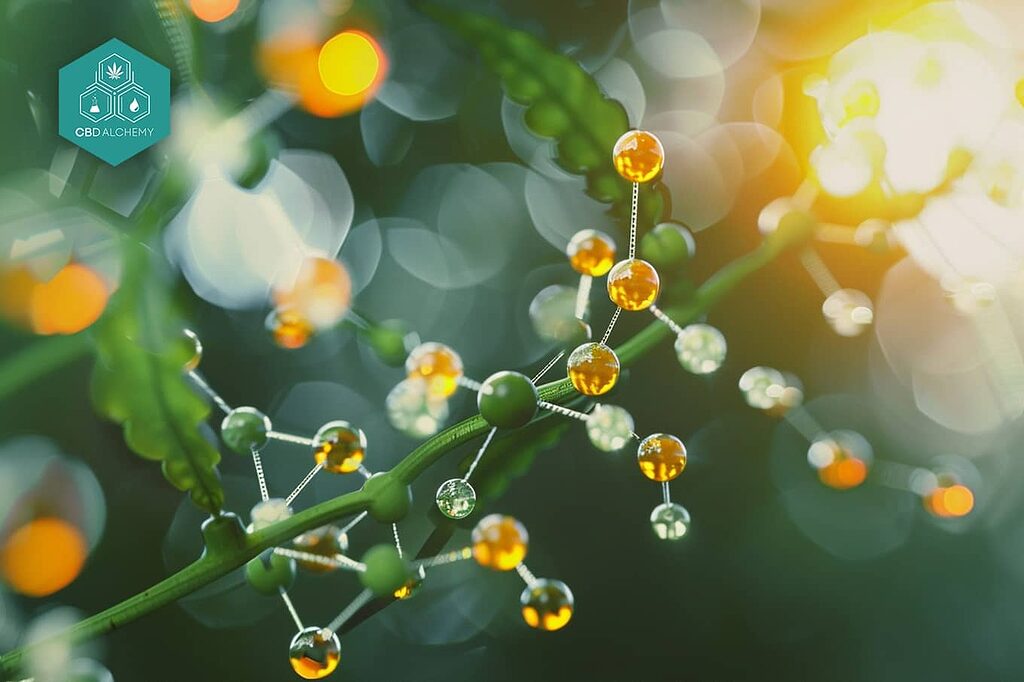
While cannabis contains hundreds of terpenes, a select few appear in significant concentrations and contribute notably to the plant’s effects. Here are some of the most prevalent and well-studied cannabis terpenes:
The unique terpene profiles of various marijuana strains contribute significantly to their distinctive aromas and effects.
Myrcene
Myrcene is the most abundant terpene in most cannabis strains. It has an earthy, musky aroma reminiscent of cloves.
Potential effects:
- Sedation
- Muscle relaxation
- Anti-inflammatory properties
Found in: Mangoes, hops, lemongrass
Limonene
Limonene has a citrusy scent and is commonly found in sativa-dominant strains.
Potential effects:
- Mood elevation
- Stress relief
- Antifungal and antibacterial properties
Found in: Citrus fruit peels, juniper, peppermint
Pinene
Pinene, as its name suggests, has a pine-like aroma. It exists in two isomers: alpha-pinene and beta-pinene.
Potential effects:
- Improved alertness and memory
- Bronchodilation (opening of airways)
- Anti-inflammatory properties
Found in: Pine needles, rosemary, basil
Linalool
Linalool has a floral, lavender-like scent.
Potential effects:
- Anxiety reduction
- Sedation
- Pain relief
Found in: Lavender, birch bark, coriander
Caryophyllene
Caryophyllene has a spicy, peppery aroma and is unique among terpenes for its ability to interact with the body’s endocannabinoid system.
Potential effects:
- Anti-inflammatory
- Analgesic (pain-relieving)
- Anxiolytic (anti-anxiety)
Found in: Black pepper, cloves, cinnamon
How Volatile Compounds and Terpenes Interact with Cannabinoids
The interaction between terpenes and cannabinoids is a key component of the entourage effect. This synergistic relationship can potentially enhance or modulate the effects of cannabis beyond what individual compounds can achieve alone.
The Entourage Effect Explained

The entourage effect posits that the combined action of various cannabis compounds – including cannabinoids, terpenes, and flavonoids – produces more significant therapeutic benefits than any single compound in isolation. This concept has important implications for both medical and recreational cannabis use.Key aspects of the entourage effect:
- Terpenes may influence how cannabinoids interact with the body’s endocannabinoid system
- Certain terpene-cannabinoid combinations may enhance specific effects while mitigating others
- The entourage effect may explain why whole-plant cannabis extracts often outperform isolated cannabinoids in therapeutic applications
Synergistic Effects of Terpenes and Cannabinoids
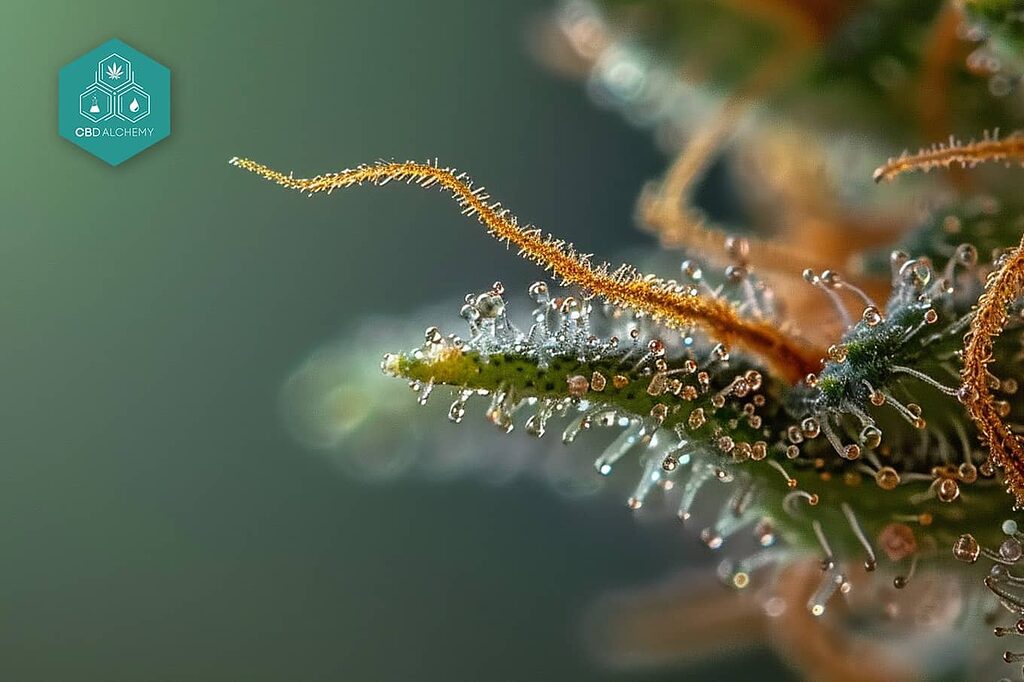
Research has begun to uncover specific ways in which terpenes and cannabinoids work together:
- Myrcene may increase the permeability of the blood-brain barrier, potentially enhancing the effects of THC
- Limonene might work synergistically with CBD to produce anxiolytic effects
- Pinene could help counteract some of the short-term memory impairment associated with THC
While more research is needed to fully understand these interactions, the growing body of evidence supports the importance of considering terpene profiles when selecting cannabis products for specific effects or therapeutic applications.
Cannabis Terpenes vs. Botanical Terpenes
As the cannabis industry has grown, so has interest in using terpenes to enhance products. This has led to a debate over the merits of cannabis-derived terpenes versus those sourced from other plants.
Differences and Similarities
Cannabis-derived terpenes:
- Extracted directly from cannabis plants
- Contain the full spectrum of terpenes found in the source strain
- Often more expensive due to regulatory challenges and limited supply
Botanical terpenes:
- Sourced from non-cannabis plants (e.g., fruits, herbs, trees)
- Can be combined to mimic cannabis strain profiles
- Generally more affordable and widely available
Both types of terpenes can be chemically identical when isolated. However, the specific ratios and combinations found in cannabis may be difficult to replicate exactly using botanical sources.
Therapeutic Properties and Benefits of Cannabis-Derived Terpenes
Proponents of cannabis-derived terpenes argue that they offer several advantages:
- Authenticity: They provide the exact terpene profile of specific cannabis strains
- Entourage effect: The natural ratios may produce more effective synergies with cannabinoids
- Full-spectrum benefits: Minor terpenes and other compounds present in cannabis extracts may contribute to overall effects
Despite these potential benefits, many producers opt for botanical terpenes due to cost considerations and regulatory constraints. As research progresses, a clearer picture of the relative merits of each source may emerge.
Essential Oils and Terpenes
Essential oils and terpenes share a close relationship, as terpenes are the primary components that give essential oils their distinctive aromas and flavors. Essential oils are concentrated plant extracts that capture the essence of the plant’s fragrance and therapeutic properties. In the context of cannabis, essential oils refer to the concentrated extracts of the plant’s terpenes, which are responsible for the unique scents and potential health benefits of various cannabis strains.
Terpenes in essential oils play a crucial role in aromatherapy, where they are used to promote relaxation, alleviate stress, and enhance mood. For instance, the terpene linalool, found in lavender essential oil, is known for its calming effects. Similarly, limonene, present in citrus essential oils, is celebrated for its uplifting and energizing properties.
In cannabis, essential oils rich in terpenes are often used to enhance the flavor and aroma of products like CBD oils, vape cartridges, and edibles. By understanding the terpene profiles of different cannabis strains, consumers can select products that align with their desired effects, whether it’s for relaxation, pain relief, or mood elevation.
Maximizing Terpene Benefits
To fully harness the benefits of terpenes, it’s essential to preserve and enhance their potency. Here are some practical tips for maximizing terpene benefits:
- Proper Storage: Store cannabis products in airtight, light-proof containers to prevent terpene degradation. Exposure to light, heat, and air can cause terpenes to evaporate or break down, reducing their effectiveness.
- Optimal Temperature: Avoid exposing cannabis to high temperatures, as heat can cause terpenes to evaporate. When using a vaporizer, set it to a lower temperature to preserve the delicate terpenes and enjoy their full flavor and therapeutic properties.
- Freshness Matters: Use fresh cannabis flowers whenever possible. Fresh cannabis retains a higher concentration of terpenes compared to older, dried-out buds. Properly cured cannabis also helps maintain terpene integrity.
- Gentle Handling: Handle cannabis gently to avoid damaging the trichomes, where terpenes are produced and stored. Rough handling can cause trichomes to break off, leading to a loss of terpenes.
- Infusion Techniques: When making edibles or topicals, use infusion techniques that preserve terpenes. For example, using a double boiler to infuse cannabis into oils at low temperatures can help retain more terpenes compared to high-heat methods.
By following these tips, you can ensure that you’re getting the most out of the terpenes in your cannabis products, enhancing both their flavor and potential therapeutic effects.
Cannabis Sativa and Terpene Content
Cannabis sativa, one of the primary species of the cannabis plant, is renowned for its high terpene content. Sativa strains are often characterized by their uplifting and energizing effects, which are largely attributed to their rich terpene profiles. These strains typically contain high levels of terpenes such as β-caryophyllene and myrcene, each offering unique therapeutic benefits.
β-caryophyllene, a spicy, peppery terpene, is notable for its ability to interact with the body’s endocannabinoid system, specifically the CB2 receptors. This interaction can provide anti-inflammatory and analgesic effects, making β-caryophyllene a valuable component in pain relief and anti-inflammatory treatments.
Myrcene, on the other hand, is known for its earthy, musky aroma and is often the most abundant terpene in many cannabis strains. It is celebrated for its sedative and muscle-relaxing properties, which can be particularly beneficial for those seeking relief from insomnia or chronic pain.
The high terpene content in Cannabis sativa strains not only contributes to their distinctive aromas and flavors but also enhances their potential medicinal benefits. By understanding the terpene profiles of various Cannabis sativa strains, consumers can make informed choices to meet their specific therapeutic needs, whether it’s for boosting mood, alleviating pain, or reducing inflammation.
In conclusion, the rich terpene content in Cannabis sativa strains underscores the importance of terpenes in the overall cannabis experience, offering a range of therapeutic properties that can enhance both medical and recreational use.
How to Use the Cannabis Terpenes Chart
Cannabis terpene charts are valuable tools for both consumers and producers to understand the potential effects and characteristics of different cannabis strains. These charts typically display the most common terpenes found in cannabis along with their aromas, potential effects, and the strains in which they are predominantly found.
Understanding Terpene Profiles
A terpene profile is the unique combination and concentration of terpenes in a particular cannabis strain. This profile contributes significantly to the strain’s aroma, flavor, and potential effects. When using a terpene chart:
- Identify the dominant terpenes in a strain
- Consider the potential effects associated with those terpenes
- Look for synergies between terpenes and cannabinoids
Selecting Cannabis Strains Based on Terpenes
To choose a cannabis strain based on its terpene profile:
- Determine your desired effects or therapeutic goals
- Identify terpenes associated with those effects
- Look for strains high in those specific terpenes
For example, if you’re seeking relaxation, you might look for strains high in myrcene or linalool. For mood elevation, limonene-rich strains might be more appropriate.
Limitations of Terpene Charts
While terpene charts are useful, it’s important to note their limitations:
- Terpene profiles can vary within the same strain due to growing conditions
- Individual responses to terpenes may differ
- The entourage effect involves complex interactions beyond just terpenes
The Future of Terpene Research in Cannabis
As the cannabis industry continues to evolve, terpene research is becoming increasingly important. This growing field of study holds promise for both medical applications and product development.
Ongoing Studies and Potential Medical Applications
Researchers are exploring various aspects of cannabis terpenes:
- Neuroprotective properties: Studies suggest some terpenes may have potential in treating neurodegenerative diseases
- Anti-inflammatory effects: Terpenes like β-caryophyllene are being investigated for their anti-inflammatory properties.
- Anxiety and depression: Research is ongoing into the anxiolytic and antidepressant effects of certain terpenes, particularly limonene and linalool.
- Pain management: Some terpenes may enhance the analgesic effects of cannabinoids, potentially leading to more effective pain treatments.
Emerging Trends in Terpene-Focused Products
The cannabis industry is increasingly focusing on terpenes in product development:
- Terpene-specific formulations: Products are being developed to target specific effects by emphasizing certain terpenes.
- Customized terpene blends: Some companies are creating proprietary terpene blends to replicate or enhance strain-specific effects.
- Terpene-infused products: Non-cannabis products like beverages and topicals are being infused with cannabis-derived or botanically-derived terpenes.
- Terpene education: There’s a growing emphasis on educating consumers about terpenes and their potential effects.
Conclusion
Terpenes play a crucial role in the cannabis experience, contributing to the plant’s aroma, flavor, and potential therapeutic effects. As research progresses, our understanding of these compounds and their interactions with cannabinoids continues to grow.
For consumers, knowledge of terpenes can help in selecting strains and products that align with their desired effects. For the cannabis industry, terpene research opens new avenues for product development and targeted formulations.
As we look to the future, it’s clear that terpenes will remain a key focus in cannabis science and product innovation. By harnessing the power of these aromatic compounds, we may unlock new therapeutic possibilities and enhance the overall cannabis experience for both medical and recreational users.
Frequently Asked Questions about Cannabis Terpenes
What are cannabis terpenes?
Cannabis terpenes are aromatic compounds found in cannabis plants, responsible for the distinctive aromas and flavors of various cannabis strains. These volatile compounds are produced in the trichomes of cannabis flowers, along with cannabinoids like THC and CBD. Terpenes are not unique to cannabis – they are found in many other plants as well, including aromatic herbs and citrus fruits.Cannabis terpenes play a crucial role in the plant’s defense mechanisms and contribute to the potential health benefits and therapeutic properties associated with cannabis use. There are over 150 different terpenes identified in cannabis, each with its own unique aroma profile and potential medicinal benefits.
What are cannabis-derived terpenes?
Cannabis-derived terpenes are terpenes that are extracted directly from cannabis plants. These terpenes are isolated from the plant material, typically through steam distillation or other extraction methods. Cannabis-derived terpenes are prized for their authenticity and potential to contribute to the “entourage effect” when combined with cannabinoids.Cannabis-derived terpenes are often used to enhance the flavor, aroma, and potential therapeutic qualities of cannabis products. They can be added back into CBD oils, vape cartridges, or other cannabis products to create specific terpene profiles that mimic those of popular cannabis strains.
What are terpenes in cannabis?
Terpenes in cannabis are organic compounds responsible for the plant’s aromatic properties. They are produced in the same glands (trichomes) that create cannabinoids like THC and CBD. Some common terpenes found in cannabis include:
- Myrcene: Often the most abundant terpene in cannabis, with an earthy, musky aroma.
- Limonene: Provides a citrusy scent, similar to lemons.
- Pinene: Gives a pine-like aroma.
- Linalool: Offers a floral, lavender-like scent.
- β-caryophyllene: Provides a spicy, peppery aroma.
These terpenes not only contribute to the distinctive aromas of different cannabis strains but may also play a role in the plant’s potential medicinal properties and effects on the human body.
Which of the following terpenes is the most abundant in cannabis?
Myrcene is typically the most abundant terpene found in cannabis. It’s present in high concentrations in many cannabis strains, particularly those with relaxing or sedative effects. Myrcene has an earthy, musky aroma and is also found in other plants like hops and mangoes.However, it’s important to note that terpene profiles can vary significantly between different cannabis strains. Some strains may have higher concentrations of other terpenes like limonene or pinene. The specific terpene profile of a cannabis strain contributes to its unique aroma, flavor, and potential effects.
Outside of cannabis, where can terpenes be found?
Terpenes are not exclusive to cannabis – they are found in many other plants and even some animals. Some common sources of terpenes include:
- Essential oils: Many essential oils are rich in terpenes. For example, lavender essential oil contains high levels of linalool.
- Citrus fruits: Lemons, oranges, and grapefruits contain limonene.
- Pine trees: As the name suggests, pine trees are a rich source of pinene.
- Aromatic herbs: Basil, rosemary, and thyme contain various terpenes.
- Flowers: Many flowers produce terpenes, contributing to their distinctive scents.
- Spices: Black pepper contains β-caryophyllene, the only known terpene that can interact with the endocannabinoid system.
Terpenes play crucial roles in these plants, often serving as natural pesticides or attractants for pollinators.
What does “cannabis-derived terpenes” mean?
“Cannabis-derived terpenes” refers to terpenes that are extracted directly from cannabis plants, as opposed to being synthesized in a lab or derived from other botanical sources. These terpenes are isolated from cannabis plant material, typically through processes like steam distillation or CO2 extraction.Cannabis-derived terpenes are valued for their authenticity and potential to contribute to the “entourage effect” – the theory that cannabinoids and terpenes work synergistically to enhance the overall effects of cannabis. They are often used to enhance the flavor, aroma, and potential therapeutic properties of cannabis products like CBD oils or vape cartridges.
How many cannabis terpenes are there?
Research has identified over 150 different terpenes in cannabis plants. However, only a handful of these are typically present in significant concentrations. The most common terpenes found in cannabis include myrcene, limonene, pinene, linalool, and β-caryophyllene.The specific terpene profile can vary widely between different cannabis strains, contributing to their unique aromas and potential effects. Some cannabis strains may have high concentrations of certain terpenes, while others may have a more balanced profile with multiple terpenes present in moderate amounts.
How do cannabis terpenes work in the body?
Cannabis terpenes interact with the body in several ways:
- Aromatherapy: Inhaling terpenes can stimulate the olfactory system, potentially influencing mood and cognition.
- Interaction with cannabinoid receptors: Some terpenes, like β-caryophyllene, can directly interact with cannabinoid receptors in the endocannabinoid system.
- Entourage effect: Terpenes may work synergistically with cannabinoids, potentially enhancing or modulating their effects.
- Direct physiological effects: Many terpenes have their own potential therapeutic properties, such as anti-inflammatory or analgesic effects.
- Enhanced absorption: Some terpenes may increase the permeability of the blood-brain barrier, potentially enhancing the absorption of cannabinoids.
The specific effects can vary depending on the individual terpene and its concentration. More research is needed to fully understand how cannabis terpenes work in the human body.
How to extract terpenes from cannabis?
Extracting terpenes from cannabis typically involves one of several methods:
- Steam distillation: This traditional method uses steam to vaporize the terpenes, which are then condensed and collected.
- CO2 extraction: Supercritical CO2 is used to extract both cannabinoids and terpenes, which can then be separated.
- Hydrocarbon extraction: Solvents like butane or propane are used to extract cannabis compounds, including terpenes.
- Cold press extraction: This method involves pressing fresh cannabis flowers to release their essential oils.
- Solventless extraction: Methods like rosin pressing use heat and pressure to extract terpenes without solvents.
Each method has its pros and cons in terms of efficiency, purity, and preservation of the terpene profile. The choice of method often depends on the intended use of the extracted terpenes and the scale of production.
How to increase terpenes in cannabis?
Growers can employ several strategies to increase terpene production in cannabis plants:
- Optimize light exposure: Proper light intensity and spectrum can boost terpene production.
- Manage temperature and humidity: Slightly lowering temperatures during the flowering stage can increase terpene content.
- Use high-quality soil and nutrients: Organic, nutrient-rich soil can enhance terpene production.
- Avoid over-fertilization: Excessive nutrients can reduce terpene levels.
- Harvest at the right time: Terpene levels peak just before full maturity of the trichomes.
- Minimize plant stress: While some stress can increase terpene production, excessive stress can be detrimental.
- Choose high-terpene strains: Some cannabis strains naturally produce more terpenes than others.
- Proper drying and curing: Slow, controlled drying and curing can preserve and even enhance terpene profiles.
What is the average percentage of terpenes in cannabis oil?
The terpene content in cannabis oil can vary widely depending on the extraction method, the cannabis strain used, and whether additional terpenes have been added. In general, the terpene content of cannabis oil typically ranges from about 2% to 10%.However, it’s important to note that some cannabis oils, particularly those marketed for their terpene content, may have higher percentages. Full-spectrum CBD oils, for example, often aim to preserve the natural terpene profile of the cannabis plant.For comparison, fresh cannabis flowers usually contain about 1-3% terpenes by dry weight, although some high-terpene strains may reach up to 5%.
What do cannabis-derived terpenes do?
Cannabis-derived terpenes serve several functions:
- Aroma and flavor: Terpenes are responsible for the distinctive smells and tastes of different cannabis strains.
- Potential therapeutic effects: Many terpenes have their own potential health benefits, such as anti-inflammatory or analgesic properties.
- Entourage effect: Terpenes may work synergistically with cannabinoids to enhance or modulate their effects.
- Product differentiation: In the cannabis industry, terpene profiles are used to create unique products and mimic specific strain effects.
- Natural plant protection: In the cannabis plant, terpenes serve as a defense mechanism against pests and environmental stressors.
- Potential mood and cognitive effects: Some terpenes may influence mood, focus, or relaxation when inhaled or consumed.
The specific effects can vary depending on the individual terpene and its concentration. More research is needed to fully understand the potential medicinal benefits of cannabis terpenes.
How to isolate cannabis terpenes?
Isolating cannabis terpenes typically involves a multi-step process:
- Extraction: Use methods like steam distillation, CO2 extraction, or hydrocarbon extraction to remove terpenes from plant material.
- Separation: Use techniques like fractional distillation or chromatography to separate individual terpenes.
- Purification: Further refine the isolated terpenes to remove any remaining impurities.
- Analysis: Use gas chromatography or mass spectrometry to verify the purity and identity of the isolated terpenes.
This process requires specialized equipment and expertise. It’s typically performed in laboratory settings rather than by individual consumers.
What are the best terpenes in cannabis to relieve pain?
Several cannabis terpenes have shown potential for pain relief:
- β-caryophyllene: This terpene can interact directly with CB2 receptors and has shown analgesic properties in studies.
- Myrcene: Known for its sedative effects, myrcene may help with pain by promoting relaxation.
- Linalool: This terpene, also found in lavender, has shown potential analgesic and anti-inflammatory properties.
- Pinene: Some studies suggest pinene may have pain-relieving effects.
- Limonene: This citrusy terpene has shown potential anti-inflammatory properties, which may help with pain.
It’s important to note that while these terpenes show promise, more research is needed to fully understand their pain-relieving properties. The effectiveness may also depend on the specific type of pain and individual factors.
How to make terpenes from cannabis?
Making terpenes from cannabis typically involves extraction rather than synthesis. Here’s a general process:
- Harvest: Collect fresh cannabis flowers at peak ripeness.
- Preparation: Freeze the plant material to preserve terpenes.
- Extraction: Use methods like steam distillation, CO2 extraction, or cold press extraction to remove terpenes from the plant material.
- Separation: If desired, use techniques like fractional distillation to isolate specific terpenes.
- Storage: Store the extracted terpenes in airtight, light-proof containers to preserve their quality.
This process requires specialized equipment and knowledge. For safety and legal reasons, it’s typically performed by licensed professionals rather than individuals.
How to use cannabis terpenes?
Cannabis terpenes can be used in several ways:
- Aromatherapy: Inhale terpenes using a diffuser or vaporizer for potential mood and cognitive effects.
- Topical application: Add terpenes to lotions or oils for potential localized effects.
- Ingestion: Add food-grade terpenes to edibles or beverages. Always ensure the terpenes are safe for consumption.
- Enhance cannabis products: Add terpenes to CBD oils or other cannabis products to create specific flavor profiles or potential effects.
- Vaping: Use terpene-enhanced e-liquids in vaporizers.
Always start with small amounts when using terpenes, as they are highly concentrated. It’s also crucial to ensure you’re using high-quality, pure terpenes from a reputable source.
Why do cannabis terpenes matter?
Cannabis terpenes matter for several reasons:
- Aroma and flavor: Terpenes give different cannabis strains their unique smells and tastes.
- Potential health benefits: Many terpenes have shown therapeutic properties in studies.
- Entourage effect: Terpenes may work synergistically with cannabinoids to enhance or modulate their effects.
- Strain differentiation: Terpene profiles help distinguish between different cannabis strains.
- Product customization: In the cannabis industry, terpenes are used to create products with specific flavors or potential effects.
- Natural plant functions: In the cannabis plant, terpenes serve important roles in defense and attraction of pollinators.
- Consumer experience: Understanding terpenes can help consumers choose products that align with their preferences and desired effects.
Understanding cannabis terpenes can provide a more nuanced approach to cannabis use, potentially enhancing both recreational and medicinal applications.



